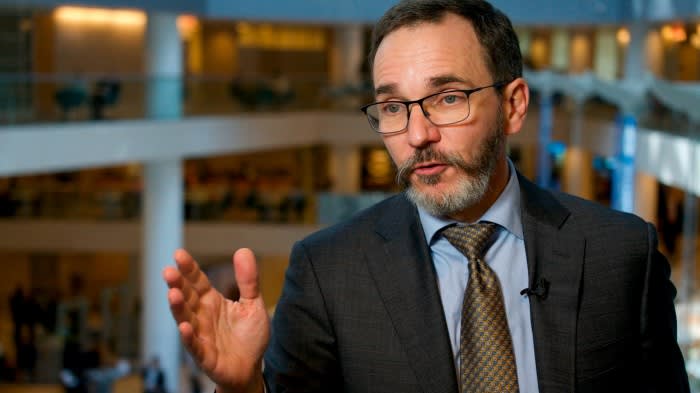
The United States is on track to grow at twice the rate of any other G7 country this year, according to International Monetary Fund forecasts, as the strength of the world's largest economy shakes international markets.
Strong household spending and investment would help push US growth to 2.7 percent this year, according to the Fund's latest data. Global economic outlook.
This figure is higher than the 2.5 percent estimated for 2023 and represents an increase of 0.6 percentage points from previous projections.
These forecasts highlight the role of the US economy as an engine of global growth, as investors around the world lower their expectations for interest rate cuts by the Federal Reserve.
The IMF said the second best performer among the G7 this year would be Canada, with growth of 1.2 per cent.
She added that Germany's expansion would be the weakest among the G7, at 0.2 percent. Japan is expected to see growth of 0.9 percent, while the UK is set to expand by just 0.5 percent after stabilizing in 2023.
Global stock markets fell and Asian currencies were hurt by a stronger dollar on Tuesday, following a sell-off on Wall Street driven by strong US retail sales figures that suggested the Federal Reserve may cut interest rates this year by less than previously thought.
Pierre-Olivier Gorinchas, chief economist at the International Monetary Fund, told the Financial Times that although the “baseline” remains three-quarters of a percentage point cuts this year, the Fed could be derailed by the US economy's rise. .
“If inflation pressures persist beyond what we have now, in the United States in particular, we would expect that they will have subsequent cuts and perhaps smaller cuts,” he said.
The Stoxx Europe 600 index closed down 1.5 percent, its worst day since July. The US S&P 500 index was little changed after the previous day's losses. The change in US interest rate expectations also affected currency markets, pushing the Indian rupiah to a record low and the Indonesian rupiah to its lowest levels in four years against the dollar.
Gorinchas added that Fed rate cuts could be delayed from this summer into the fourth quarter — perhaps after the presidential election in November — if inflation exceeds IMF expectations.
US President Joe Biden hopes that US economic strength will help him overcome his deficit in the opinion polls against Donald Trump, the presumptive Republican nominee.
An FT-Michigan Ross poll this week showed the number of registered voters who approve of Biden's handling of the economy is rising but remains a minority, and nearly four in five expressed deep concern about inflation. Any delay in the Fed's interest rate cuts could also impact the president's re-election hopes.
At present, investors expect the Fed to cut interest rates by September and perhaps more than once by the end of the year.
Recent bumper growth in the United States has helped the global economy avoid the long-feared sharp decline in the wake of rising interest rates.
But strong demand has also led to higher price pressures, in contrast to the UK and the eurozone.
The International Monetary Fund said inflation in the United States would continue to decline but raised its forecast for this year to 2.9 percent, higher than the 2.4 percent expected for the euro zone and 2.5 percent in the United Kingdom.
Gorinchas said the European Central Bank and the Bank of England could cut interest rates sooner because they do not face such a “strong component of demand-driven inflation.”
Presenting its forecasts while central bank governors and finance ministers attended the joint spring meetings of the International Monetary Fund and World Bank in Washington, the Fund found that global economic activity proved “surprisingly resilient” even after central banks raised interest rates to reduce inflation.
But he also warned of risks to the global recovery, in particular the possibility of new increases in commodity prices as a result of the conflict in the Middle East.
The broader picture remains one of tepid expansion by historical standards, with global growth expected to remain at 3.2% this year and next, in line with 2023 estimates.
The IMF said the long-term consequences of the coronavirus pandemic, Russia's large-scale invasion of Ukraine, weak productivity growth and increasing “geoeconomic fragmentation” were hampering the expansion.
The International Monetary Fund said the reason for the decline in inflation in advanced economies was supported by a stronger-than-expected rise in employment, partly due to migrant flows. The report found that there has been faster growth in the foreign-born rather than domestic-born workforce since 2021 in economies including Canada, the euro zone, the United Kingdom and the United States.
Among other leading economies, the International Monetary Fund expects China's growth this year to slow to 4.6 percent from 5.2 percent in 2023, while the forecast for India, one of the world's fastest growing economies, was upgraded to 6.8 percent for this year.
Russia had one of the biggest improvements, with growth now expected to reach 3.2 percent this year, 0.6 percentage points higher than previously expected, followed by 1.8 percent growth in 2025. The International Monetary Fund doubled its growth forecast Russia in its report issued in January. The expectations fueled fears among the G7 countries that the sanctions would fail to harm the war economy led by Vladimir Putin.
Gorinchas said Russian expansion was driven in part by strong oil export revenues coupled with strong private investment.
“Domestic demand is very strong,” he added. He added: “The sanctions are still humiliating and are having a gradual impact on the Russian economy, but the economy itself is very resilient.”

“Web maven. Infuriatingly humble beer geek. Bacon fanatic. Typical creator. Music expert.”






More Stories
Bank of Japan decision, China PMI, Samsung earnings
Dow Jones Futures: Microsoft, MetaEngs Outperform; Robinhood Dives, Cryptocurrency Plays Slip
Strategist explains why investors should buy Mag 7 ‘now’